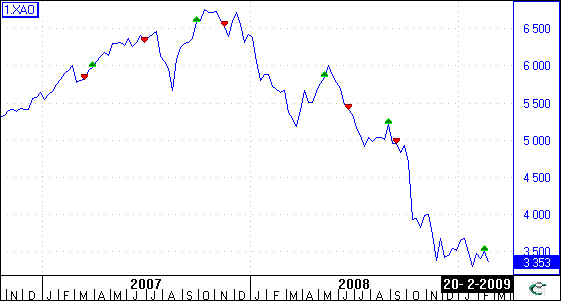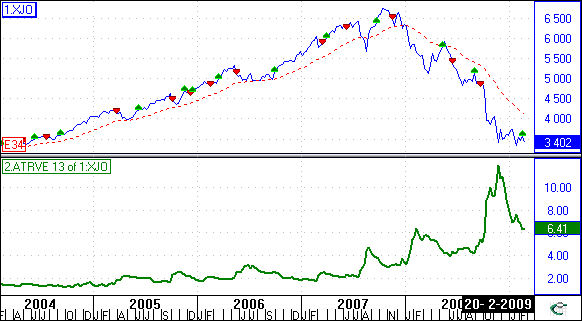It’s now been two weeks since SPA3 generated a Low Market Risk signal on the Australian market . For users of the SPA3 system this indicates they can increase their position sizing for new buy signals on individual stocks. However, there are absolutely no guarantees that the market will remain low risk, and may indeed even turn high risk again very quickly as we saw in September of 2008. Then, a low risk market indicator was provided by SPA3 on August 29 2008 and was quickly followed by a high risk market indicator just 18 days later!

Figure 1. ALL ORDS
There are some differences between September 2008 and now. Back then, market volatility as measured by the Average True Range (ATR) was rising sharply, and share prices were trading in huge intraday ranges. Now, the ATR has contracted and appears to be, like the market itself, in a period of consolidation. Periods of lower volatility will always pre-cede periods of higher volatility. There is no correlation between volatility and future price moves, other than a suggestion that prices will break out of congestion and low volatility, and move relatively quickly either up or down. This can be seen in Figure 2 below. During winter 2008 the volatility contracted or ‘washed out’ prior to the low market risk indicator in September. The market then imploded sharply and suddenly in the following months and as prices tumbled the volatility exploded. As the market has consolidated into a trading range over the past 4 months, volatility has consolidated as well.

Figure 2. XJO with ATRVE
It is now that active investors need to deploy their trading strategy, and be prepared mentally and emotionally for the future moves of the market. If the market remains low risk and emerges from this current period of consolidation into a medium term uptrend then profits from long side trades will be generated. If the market breaks lower from this period of consolidation, then decisive action will need to be taken as and when the sell signals are given and if a high market risk signal appears. Those using a hedging strategy (SPA3 customers) will then cover or hedge their long positions and portfolio’s using their hedging tool of choice – either the SPI Futures contract or an Index CFD.
It is during these times that our patience, discipline, trading rules and self belief systems are fully tested by the market. Those that are prepared, have a well documented trading plan, and are able to take decisive action, will be able to participate in the market. They will be thinking in terms of probabilities and overall returns, rather than focusing on the results of each and every trade as it unfolds as either a winner or a loser. Having researched and understood their system fully they will execute trades according to the rules of the system, using its unambiguous entry and exit signals to mechanically execute trades in the market. They will also have prepared themselves mentally, knowing that there are a range of outcomes that could occur, and have readied themselves to take the necessary action required based on this range of outcomes.
Where the market goes from here is open to speculation and great debate. There are some predicting that the lows are in place, the worst is behind us, and that markets will soon begin to reflect this change in investor and trader sentiment and begin a slow and cautious recovery. There are others predicting the sky is about to fall, that the worst is yet to come, and equity prices are yet to capitulate. Regardless of all this ‘noise’ and chatter, it is our job to simply react to the signals of our trading system, and to avoid the mistake of trying to predict and forecast what the market will do. As individual investors, the market is bigger than, and independent of, all of us. Collectively it represents the opinions and actions of hundreds of thousands of decisions each and every day. It is impossible to know the outcome of all of these. Far better to have a well researched system, clear rules for entry and exit, a clear mind, and the ability to think and act in terms of market probabilities and outcomes, than to attempt to survive randomly selecting ‘one-off’ trades.
If you would like a demonstration of SPA3 simply register your details at the following link.



Reply to Comment by Jack FRYER:
Of course, this year is 2009!! Thank you Jack. I have edited the blog.
Regards
Gary
Hello Gary, I’ve recently attended my financial advisors ‘lectures’ about the state of the econonmy etc… or as you so poetically call it “noise”. I love coming back to ShareFinder info that isn’t crystal ball gazing it’s just pure and simple no emotions FACT! Thanks again, Clare
Gary,
Your plot of the XJO showing the Low Risk Points, especially the last three, does not inspire me with confidenace. The last three and others are at peaks in the plot! The little Red triangles are also way down the plot. This seems to indicate that your signals are too slow for the current climate. This has worried me about your other siganls for individual stocks.
Hi Gary this all makes sense one thing that stands out though you say that the low risk signal this time could be a good one because of the lower volatility on the all ords if this is the case could a High volatility on the all ords be a high market risk signal?
Reply to Comment by Malcolm:
Do the Low Risk points in 2003 – 2007 also not inspire you with confidence? As I always say, investors need to develop a mindset of neutrality by overcoming biases through becoming objective. Wrt to entry and exit signals this means looking at signals in up and down markets. Also, amongst other things, you must beware of the sample of one of two or three and then applying the results of the tiny sample in only a down (or up) market to the full sample.
The SPA3 Low Risk and High Risk signals on the ALL-ORDS have a brilliant medium term edge over multiple bull and bear markets. Live trading over 10 years has proven this.
Regards
Gary
Gary,
In paragraph 2 you twice refer to the year 2007. Did you mean that or 2008 which seems to better match data, alhough very similar?
Regards
Jack